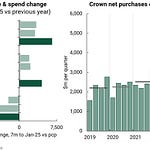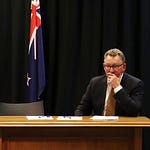TLDL & TLDR: The electricity generation and retailing industry’s already tenuous hold on a social license to operate appeared to break decisively yesterday.
Finally, the market structure’s major flaw — its inability to build enough affordable new supply soon enough to achieve carbon zero — was rudely exposed with blackouts for thousands of households on the coldest night of the year. The industry has been running generation on the precipice of a shortage for years to keep prices and profits high. All it took was some weed blocking a power plant and a surprise lack of wind in one location to finally tip it over the edge. Now there is all hell to pay.
The power cuts couldn’t have come at a worse time: just as the IPCC issued its ‘red alert for humanity’ at 8pm NZ Time on the need to move urgently to renewable energy. The political fallout was immediate and intense, in part because the ‘no surprises’ rule was well and truly broken.

Consumers had no idea the rollout blackouts were coming as they fired up their heat pumps and stoves for family dinners around 7pm last night. Only the industry knew, and then only for a couple of hours.
The Minister was first informed by OneNews Political Editor Jessica Mutch-McKay around 8.30pm.
Market reform, including the potential break-up of the three state-controlled gentailers Meridian, Mercury and Genesis, is now much more likely, although still dependent on the Government’s appetite to overcome the industry’s until-now fortress-like status quo bias and the Cabinet’s ability to execute. Both remain in doubt, but something will need to be done, or at least seen to be done to satisfy consumers, both large and small, voters and ministers after Monday night’s debacle.
Energy Minister Megan Woods faced calls to resign and needed the support of PM Jacinda Ardern in initial questioning by the Press Gallery (including me in the clip in the podcast above above) yesterday morning. Hours later in Parliament, she threw the 51%-state-owned Genesis Energy under the bus yesterday in blaming it for Monday night’s blackouts, saying it had chosen not to fire up its third coal-fired boiler at Huntly for commercial reasons.
But her wider comments in a prepared statement to Parliament suggest she and the Cabinet re thinking more widely about reform. The bolding is mine.
“Regardless of the mechanisms of the electricity market, New Zealanders rightly expect the lights to be on and the heaters to be running on a cold winter's night. That's why the situation that unfolded yesterday was unacceptable. If we're going to have a market-orientated system providing security of supply, then that market must deliver. The market failed in this respect.” Megan Woods in Parliament.
The Minister then followed up with confirmation she convened an urgent meeting of officials to launch a review into the incident, and noted the Government had been worried about high prices in the wholesale market, which have driven independent retailers who buy power on the wholesale market, Flick Electric, Electric Kiwi and Nau Mai Rā , out of either taking new customers (Flick) or marketing for new customers (Electric Kiwi). Nau Mai Rā is offloading customers.
Flick launched a petition in June calling for structural separation of the Gentailers into separate retailers and wholesalers, or making all retailers buy off the market. The gentailers can ‘buy’ off themselves currently.
“The recent spike in high electricity prices as a result of the dry hydrological year and a short-term gas supply issue led me to seek analysis on this from the Electricity Authority. Yesterday's events have prompted further questions on whether the system is fit for purpose.” Megan Woods
Even the EA is moving…to launch reviews…
Reinforcing the change in tone about the market overall, the Electricity Authorityannounced at midday it had launched a project to “explore long-term resilience and security of electricity supply.” It said this was part of its response to the recommendation in the May 2019 Electricity Price Review’s final report recommendation (G2 from page 63) to: “Examine the security and resilience of electricity supply.” That recommendation was supposed to be done by May 2020.
The EA said it had asked Transpower to advise by the end of the year on “how the national power system might evolve” and a plan “for monitoring and addressing these challenges and opportunities,” by March 2022.
It also pointed to an quiet announcement last week of a ‘price discovery project’ by its Market Development Advisory Group (MDAG), which is due to report to the EA’s board by the end of April 2022. Tony Baldwin is the chair of that group. The EA is also due to release the result of a review of the wholesale market next month, which it gave more background on here.
What’s the problem here?
This all sheets back to the original structure of the electricity market, which was designed to be as ‘efficient’ as possible. The market was structured so a price was discovered that matched the demand for the marginal unit of power with a marginal unit of supply. That price was then smeared across every unit of generation. It effectively incentivises generators to minimise the amount of supply they offer to keep prices high.
As Brian Leyland pointed out today in this NZ Herald-$$$ piece: “The underlying failure was the decision to choose a market design based on buying and selling short-term kw/hours, rather than the recommended option of a single buyer market.”
Also, as Major Electricity Users Group (MEUG) chairman John Harbord said in April (Stuff):
“In a workably competitive market, you’d expect to see downward pressure on prices through competition and we just don’t see that in New Zealand. Generators themselves are almost incentivised to keep the market on the ‘precipice of shortage’ because that is where they can sell the individual units at the highest possible price” MEUG Chair John Harbord.
Until this week, Woods has been reluctant to go down the path of breaking up the Gentailers ‘Telecom-style’ into a single or multiple separate wholesale generators and separate retailers.
Dividends and debt reduction trump everything
She hasn’t said as much, but the Government has been relying on the juicy dividends from Meridian, Mercury and Genesis to help it get back to surplus, which is its main aim as a Government. Breaking them up puts that in danger and shows how deeply conflicted the Government is, as both owner and regulator.
In April she said of a potential breakup along generator and retailer lines (the bolding is mine): (Stuff):
‘While a reform of that nature was not on her work programme, she was “not saying it is resolved for all time. Is it something that may have to be revisited in the future? Probably, maybe.’” Megan Woods.
‘Probably, maybe’ did not inspire confidence that Woods was convinced or committed to such a change, especially given the Government’s own financial drivers.
The Public Finance Act specifies the Government must run surpluses where possible after a crisis to reduce debt. Labour has repeatedly signed up to this core restraint on the Government’s actions.
Since the initial crisis of Covid-19 passed, the Labour-led Government has prioritised lower debt over reducing child poverty, investing in affordable housing and incentivising lower carbon emissions.
Coal-fired power prices paid for no-cost hydro power
Currently the wholesale market is prioritised to reduce investment in new generation to a minimum, as the market’s failure on Monday night showed.
The market structure’s focus on marginal pricing to maximise marginal profit came home to roost on its basic flaw: its inability to create affordable and secure new generation capacity that is renewable. It has led to one million tonnes of coal being burned over the last year.
This fact cited by the EA’s MDAG stood out like the proverbial red alert:
“Since the New Zealand wholesale electricity market began operating in October 1996, around 1600 MW of new renewable generation has been built in this country, and around 1500 MW of existing thermal generation has been retired. Projections generally suggest that new renewable generation will need to be built at a rate materially faster than the industry achieved over the market’s first 15 years.” EA MDAG
In other words, there has been virtually no net renewable generation capacity created in 25 years. As this chart from the EA in its submission to the Climate Commission shows, the largest amount of new generation added since 1996 was from coal and gas. It’s the light blue band. The green, yellow and blue bars are wind, hydro and solar. The grey is Geothermal, which is a large emitter of climate emissions too… ie less than half the new generation capacity added in the last 25 has been renewable. More than half was gas and coal. The amount of solar added was pitiful.
How are we expected to get to carbon net zero by 2050 when the incentives are there for the gentailers to keep drip feeding coal and gas generation into the market to keep prices high so they can maximise profits on hydro-powered electricity generated from dams built and paid for before 1996, and which do not pay for the raw ingredient: water.
Market built before climate mattered and when demand was flattening
The market was set up for a pre-Climate Change-driven world and for a market with flat to falling demand. Even the EA recognises the need for a new market structure, and the potential for Government intervention.
“The energy strategy must canvas whether there are areas in which the investment challenge may not be met by the private sector under existing settings, and whether changes to these settings – and/or direct intervention by Government – may be required.” EA in submission to Climate Commission.
The EA’s MDAG review proposal hints at the problems in its inquiry questions list:
How the spot market will promote efficient operation on a daily and inter-seasonal basis when a high proportion of generation has low or zero marginal cost of operation (i.e. short-run marginal cost or SRMC)
How water will be priced, without thermal plant in the market
How the wholesale market will enable efficient investment when supply is dominated by low-SRMC generation
The EA’s Chief Strategy Officer James Tipping also hints at it in the release on the review of long term security of supply (again, bolding is mine):
“A goal of 100% renewable electricity generation represents a material increase in renewables, such as wind and solar generation, over current levels. This presents new challenges to the operation of and investment in the electricity system, and to maintaining a secure, reliable and resilient electricity supply. Electricity systems worldwide, and in New Zealand, have been designed on the assumption that a material proportion of generation is fuelled by fossil fuels. Supporting services to keep the power system stable are typically provided by a range of long-established technologies. Moving towards 100% renewables in New Zealand, and the uptake of new technology, present opportunities for other technologies to provide the system services that have been supplied predominantly by hydro generation and supported by fossil fuels, particularly when insufficient hydro is available.” James Tipping.
Those other technologies include distributed solar generation and batteries, which the gentailers have shied away from. See a lot more on that from me in this recent podcast and article on solar power, and this on Rio Tinto’s smelter profits.
So what happens now?
Genesis CEO Marc England is scheduled to meet Megan Woods in the Beehive later today. It was a long-planned meeting, but will be extra spicy after he lashed back at Woods’ decision to throw Genesis under the bus. He told RNZ Woods was unfairly scapegoating Genesis, which was hit by a surprise weed problem at Tokaanu, a surprise wind problem and did not have time to fire up its third coal turbine. He then blamed Transpower and the Minister herself.
“Transpower as a company has the overall visibility of the market and what's going on and ministers are ultimately accountable for energy security as a whole.” Marc England.
Status quo bias and regulatory capture risks
Woods will, no doubt, fire up the EA to come back with some real options for reform. The industry will, no doubt, just as quickly fire up to say nothing is broken and nothing needs to change.
It is slightly concerning that the EA’s wholesale market review due next month has followed previous reports downplaying previous wholesale price hikes. It is very invested in the current structure. The experts it takes advice are also firmly embedded within the existing generation and distribution system. Regulatory capture is a risk.
The ultimate outcome depends on how determined Woods is to make change (‘probably, maybe’) and whether she and Cabinet have the bandwidth to reform the electricity sector as well as the health, vocational tertiary eduction, RMA, Local Government and DHB systems. Not to mention housing, where Woods has a tiger by the tail.
My bet is nothing changes
The PM has not risked any political capital on dealing with climate change so far. Labour dropped its ‘single buyer’ joint plan with the Greens before the last election because it was seen internally as too ‘radical’ and distracting for voters. The Government has also floated the idea of a massive hydro ‘battery’ at Lake Onslow, which would be Government owned and could be used to drip feed power into the market in response to spikes like those seen in recent months.
The problem is that Onslow is already facing heavy opposition from gentailers who loathe the idea, given it would endanger their large profit margins between coal prices and water costs. It is also unlikely to be in operation for at least 20 years.
That will be way too late to respond credibly to the IPPC’s clarion call on Monday night.
Briefly elsewhere in the news








Useful longer reads and listens




Some fun things




















Share this post